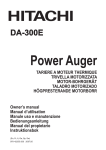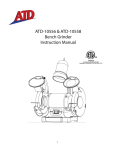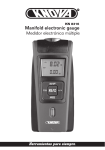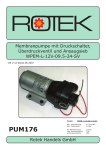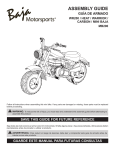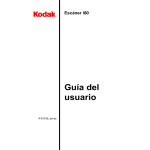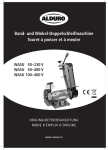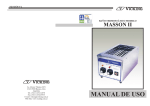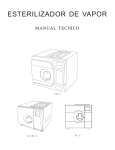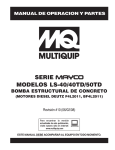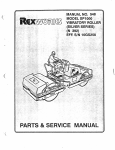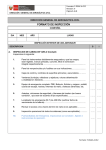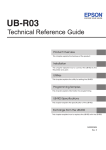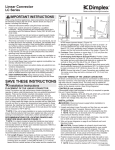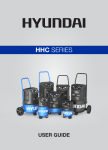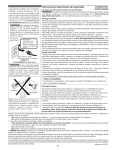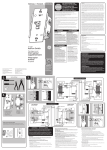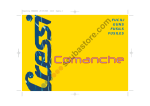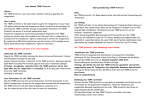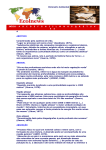Download KN 7060 KN 7070
Transcript
KN 7060 KN 7070 TABLE OF CONTENTS Specifications ...................................................................... 2 Important safety rules .......................................................... 3 Know your bench grinder ...................................................... 4 Operating instructions ...................................................... 5-10 Maintanance ....................................................................... 11 Troubleshooting .............................................................. 12,13 Exploded view and parts list .......................................... 14,15 Warranty ............................................................................. 16 SPECIFICATIONS Model # Motor Type: Motor Ratings: Horsepower: Wheel Diameter: Wheel Width: Arbor Hole: No load Speed: Wheel Grits: KN 7060 Induction 120 V AC, 60 Hz 1/2 HP 6” (150 mm) 3/4” (20 mm) 1/2” (13 mm) 3450 RPM 36 (Coarse) / 60 (Medium) KN 7070 Induction 120 V AC, 60 Hz 3/4HP 8” (200 mm) 1”(25 mm) 5/8” (15.88 mm) 3450 RPM 36 (Coarse) / 60 (Medium) Important Safety Rules DANGER Failure to observe any of the following instructions could result in severe personal injury to tool user and bystanders or cause damage to tool and property! WARNING Read, understand and observe all instructions in this manual before using or operating the tool for which it is written and supplied. Ensure that anyone who is to use the tool has read and understood the instructions provided. • Always wear eye protection that complies with a recognized standard (CSA or ANSI). • Wear a mask or respirator when dust is generated. • Keep bystanders out of the work area while operating the tool. • WARNING! Always ensure that the work area is clear of any flammable materials, liquids or gasses, because the use of this tool may create sparks. • Tighten grinding wheel lock nuts, securing bolts and all clamps and guards. • During each start-up, stand to one side of the grinder and switch it ‘On’. Let the grinder operate at full speed for approximately one minute so that any undetected flaws or cracks will become apparent. • To avoid electric shock, DO NOT use in damp conditions or expose to rain. • When fitting a new grinding wheel, always check that the stated maximum RPM meets or exceeds that stated on the grinder. Also check the new wheel for damage, such as flaws or cracks. If the wheel appears satisfactory, fit it to the grinder. • When a new grinding wheel has been fitted, stand to one side of the grinder and switch it ‘On’. Let the grinder operate at full speed for approximately one minute so that any undetected flaws or cracks will become apparent. • Use only accessories that are recommended by the manufacturer for your model. • DO NOT attempt to cut anything with the grinding wheel. • Grounded tools must be plugged into an outlet that has been properly installed and grounded in accordance with all local codes and ordinances. Never remove the grounding prong from the plug or modify it in any way. Do not use adaptor plugs. If in doubt as to whether the outlet is properly grounded, consult a qualified electrician. • Do not use the tool when tired or under the influence of drugs, alcohol or medication. • Do not wear loose clothing or jewellery. Keep hair tied back. • Ensure the power switch is off prior to plugging in the tool. • Keep guards in place and working properly. • WARNING! Replace cracked grinding wheels immediately. • Keep hands clear of grinding wheels. • Do not overtighten spindle nuts. • Never reach behind or beneath the grinding wheels. • Adjust tool rests whenever necessary to maintain a distance of 1/8” (3.2 mm) from the grinding wheel. • Unplug from power supply before adjusting or servicing. The grinding wheels continue to rotate after the tool is switched off. Always allow wheels to stop before adjusting or servicing. • Service on these tools should only be performed by an authorized, qualified technician. KNOW YOUR GRINDER Pain eye shield Magnify eye shield Spark deflector Grinding wheel (60 Grit) Grinding wheel (36 Grit) Tool rest (Right) Tool rest (Left) On/Off switch Bolt-down hole Water tray Operating Instructions an electric cord that has an equipment grounding conductor and a grounding plug. The plug MUST be plugged into a matching outlet that is properly installed and grounded in accordance with ALL local codes and ordinances. DO NOT MODIFY THE PLUG PROVIDED. If it will not fit the outlet, have the proper outlet installed by an electrician. Before You Start - Safety • Always wear eye protection that complies with a recognized standard (for example: ANSI Z87.1) - (CSA or ANSI). • Wear a mask or respirator when dust is generated. • Keep bystanders out of the work area while operating the tool. • WARNING! Always ensure that the work area is clear of any flammable materials, liquids or gasses, because the use of this tool may create sparks. • Do not wear loose clothing or jewellery. Keep hair tied back. • WARNING! Replace cracked grinding wheels immediately. • Do not overtighten spindle nuts. • Adjust tool rests whenever necessary to maintain a distance of 1/8” (3.2 mm) from the grinding wheel. • NEVER grind on the side of the wheel. Grind on the face of the wheel only. • NEVER apply pressure to the workpiece when the grinding wheel is cold. Allow the wheel to warm up by applying the workpiece gradually. • NEVER use the grinder without the wheel guards. Keep thumbs and fingers away from the wheel. 3- Pronged Plug Grounding Prong Properly Grounded 3-Holed Receptacle Fig. 2 IMPROPER CONNECTION of the equipment grounding conductor can result in increased risk of electric shock. The conductor with the green insulation (with or without yellow stripes) is the equipment grounding conductor. If repair or replacement of the electric cord or plug is necessary, DO NOT connect the equipment grounding conductor to a live terminal. CHECK with a qualified electrician or service personnel if you do not completely understand the grounding instructions, or if you are not sure if the tool is properly grounded. This tool is intended for use on a circuit that has an outlet that looks like the one illustrated. The original tool has a grounding plug that looks like the plug illustrated (Figure 2). Before You Start – Electrical In the event of a malfunction or short circuit, grounding provides the path of least resistance for electrical current, and reduces the risk of electric shock for the operator. This tool is equipped with 2 Use of Extension Cords USE ONLY THREE-WIRED EXTENSION CORDS that have 3-pronged plugs and 3-holed outlets that accept the tool’s plug. Repair or replace damaged or worn cords immediately. Be sure your extension cord is properly wired and in good condition. Do not use damaged extension cords. Always replace a damaged extension cord. When using an extension cord, be sure to use one heavy enough to carry the current your product will draw. An undersized cord will cause a drop in line voltage, resulting in loss of power and overheating. The table below shows the correct size to use according to the cord length and the amperage draw of the tool (specified on the nameplate). When in doubt, use the next heavier gauge. The smaller the gauge number, the heavier the cord. (AWG = American Wire Gauge). Minimum Gauge for Extension Cords (AWG) (when using 120 volts only) Ampere Rating More Than Not more Than 0 6 6 10 10 12 12 16 Total Length of Cord in Feet (meters) 25’ (7.6m) 50’ (15m) 100’ (30.4m) 150’ (45.7m) 18 16 16 14 18 16 14 12 16 16 14 12 14 12 Not Recommended Use a separate electrical circuit for your tools. This circuit should not be less than a #12 gauge wire, and should be protected with a 15 A time-lag fuse. Before connecting the motor to the power line, ensure the switch is in the OFF position and the electric current is rated the same as the current stamped on the motor’s nameplate. Running at a lower voltage will damage the motor and is not covered by warranty. Before You Start – Package Contents Eye shield assembly mounting washer D6 ........................... Eye shield assembly mounting locking washer D6 ............... Fix work rest ...................................................................... Adjustable work rest ........................................................... Coolant tray ........................................................................ Spark deflector ................................................................... Spark deflector fixing screw assembly ................................ Left work rest ....................................................................... 1 Right work rest ..................................................................... 1 Plain eye shield .................................................................... 1 Magnifying eye shield ........................................................... 1 Eye shield fixing knob ........................................................... 2 Eye shield mounting rod – one left, one right Eye shield assembly mounting bolt M6x30 ........................... 2 2 2 2 2 1 2 2 Before You Start – Assembly and Installation Mounting the Grinder to the Workbench Before attempting to use this grinder, it must be properly mounted to a workbench or grinding stand. CAUTION! Bench grinders vibrate. Grinder movement during high-speed rotation may cause injury or damage to the workpiece or operator. Mount the grinder securely to a sturdy workbench or grinding stand. Eye Shield Installation Eye shields must be installed before operating the bench grinder. 1. Mount the left and right shield rods to the inside of the wheel guards using hex bolts. 2. Once shield rods are firmly in place, Eye shield slide the shield bracket mounting arm Safety eye onto the shield rod. shield 1. Position the grinder on the workbench. 2. Mark the workbench through the two mounting holes located in the grinder base. 3. Drill holes in the Bolt workbench at the flat marks. washer 4. Using two long bolts, washers, lock-washers and nuts, as shown (not supplied), secure Workbench the grinder to Flat washer the workbench. Hex nut Washer Hex bolt Adjustable knob 3. Tighten the carriage bolt, leaving it loose enough to allow the safety shield to be raised and lowered easily. NOTE: The eye shield should move freely when being adjusted, but stay in place when the locking knob is tightened. 3 Eye shield Before You Start – Assembly and Installation WARNING Turn the power off and remove the plug from the outlet before changing the grinding wheels. When turning the grinder on with a newly installed wheel, DO NOT STAND IN FRONT OF THE GRINDER. Stand to the side and allow the grinder to run for at least one minute before proceeding to use it. Installing or Changing the Wheel 1. Use a screwdriver to loosen the wheel cover. 2. Fit an appropriately sized wrench on the spindle hex nut. 3. Loosen the wheel nut in a clockwise direction for the left side and a counter-clockwise direction for the right side. 4. Remove the outer flange and grinding wheel. To remove the hex nut, turn the wrench and nut until the wrench is resting on the workbench behind the tool. 5. Inspect the new wheel carefully to ensure there are no cracks, chips or other damage. 6. Wipe the flange surfaces clean, and install the new wheel, flange and the spindle hex nut. 7. To install a new grinding wheel, reverse the above procedure. 8. Be sure the grinding wheel and outer flange are properly seated on the spindle shaft. 9. Replace the wheel cover and reposition the tool rest. When turning the grinder on with a newly installed wheel, DO NOT STAND IN FRONT OF THE GRINDER. Stand to the side and allow the grinder to run for at least one minute before proceeding to use it. IMPORTANT! Do not overtighten the spindle hex nut, because this may cause the wheel to crack. CAUTION DO NOT INSTALL OR USE A DAMAGED GRINDING WHEEL. The force of rotation may cause a damaged wheel to fly apart, and could injure operators or bystanders. Screw Inner flange Grinding wheel Outer flange Wheel guard cover Nut Tool Rest Adjustments and Installation Using Your Bench Grinder This Bench Grinder is ideal for use in sharpening chisels, axes and Washer other wood-cutting tools. It is also useful for repairing tips on screwAdjusting knob drivers and drill bits or for removing excess metal burrs from pieces of cut metal. Tool rest Carriage bracket bolt With the proper accessories, this tool can be used for cleaning metal surfaces using a wire brush or for buffing and polishing using a cloth Pin wheel. ON/OFF Tool The rocker ON/OFF power switch is located on the front of the grinder. rest asembly 1. Press the side marked ON to turn the grinder on. 2. Press the side marked OFF to turn the grinder off. Washer Grinding Star washer Adjusting • Adjust the tool rest to accommodate large or unusually shaped knob workpieces. Mount the tool rests to the work rest bracket using the knob and • Always keep the workpiece moving across the face of the grinding washers. wheel. Grinding continuously on the same spot on the wheel will cause Before tightening the knob, adjust the gap between the grinding grooves to be worn into the wheel. The wheel may crack or become wheel and the work rest to a maximum of 1/8” (3.2 mm). Tighten damaged more easily, and grinding of other objects will be difficult. securely. • If the workpiece becomes hot, dip it into the water or oil to cool it. • Always grind on the face of the wheel (around the diameter), NEVAdjustments To prevent the workpiece from being pulled and caught between the ER on the sides. Side pressure on grinding wheels can cause cracktool rest and the wheel, readjust the tool rest position whenever nec- ing and damage. essary to maintain the 1/8” (3.2 mm) distance. • If the face of the grinding wheel is worn unevenly, becomes grooved, or is no longer smooth and flat, the wheel should be reshaped with a 1. Loosen, but do not remove, the knob holding the tool rest arm. dressing tool (not supplied). 2. Slide the tool rest in or out to achieve a 1/8” (3.2 mm) distance • If the diameter of the grinding wheel is no longer round, the wheel from the grinding wheel surface. should be reshaped with a dressing tool or replaced. 3. Re-tighten the lock knob. • If the surface of the wheel becomes loaded and dull with workpiece material, the wheel should be cleaned with a dressing tool. 4 • After reshaping, always readjust the tool rests and spark arrestors. Tool rest (right) Maintenance Maintenance Required 1. Check power cord 2. Check wheels for cracks 3. Check moving parts for alignment and binding issues 4. Dress Grinding Wheels 5. Replace Grinding Wheels (see manual section for specifics) 6. Clean and vacuum dust from the motor housing and other grinder parts 7. Replace work-light bulb Frequency Before each use. Before each use. Service beyond recommended maintenance on these tools should only be performed by an authorized, qualified technician. COOLANT TRAY When grinding, metal objects become heated quickly. It is important to keep moving the object back and forth across the face of the grinding wheel and to cool the object frequently using the coolant tray. Before each use. As needed. As needed. As needed. As needed. Collant tray Troubleshooting Service on these tools should only be performed by an authorized, qualified technician.securely. SYMPTOM Motor will not start. PROBABLE CAUSE 1. Low Voltage. 2. Open circuit in moto or loose connections. 3. Blown fuse or breaker. CORRECTIVE ACTION 1. Check power source for proper voltage. 2. Inspect all lead connection on motor for loose or open connections. (Send for Servicing.) 3. Short circuit. (Send for Servicing.) 4. Improper match between tool and circuit, fuse or breaker. Motor will not start – fuses or circuit breakers tripping or blowing. 1. Short circuit in line, cord or plug. 2. Short circuit in motor or loose connections. 3. Incorrect fuses or circuit breakers in power line. 1. Inspect cord or plug for damaged insulation and shorted wires. 2. Inspect all connections on motor for loose or shorted terminals and/or worn insulation. 3. Install correct fuses or circuit breakers or switch tool to an appropriately sized circuit. Motor overheats. 1. Motor overloaded. 2. Extension cord too long and of insufficient gauge (weight). 1. Reduce load on motor. 2. Utilize an extension cord of appropriate gauge and length or plug tool directly into outlet. Motor stalls (resulting in blown fuses or tripped circuit). 1. Short circuit in motor or loose connections. 2. Low voltage. 3. Incorrect fuses or circuit breakers in power line. 4. Motor overload. 1. Inspect connections on motor for loose or shorted terminals or worn insulation. (Send for Servicing.) 2. Correct low voltage conditions (for example: improper extension cord length and/or gauge). 3. Install correct fuses or circuit breakers or plug tool into an appropriate circuit, matched to an appropriate fuse or breaker. 4. Reduce the load on the motor. Machine slows when operating. 1. Feed rate too great. 1. Reduce the rate at which the workpiece is fed into the working area of the tool (grinding wheel). Wavy condition on surface of workpiece. 1. Machine vibrating. 2. Workpiece not being held firmly. 3. Wheel face uneven. 4. Wheel is too hard. 1. Ensure machine is securely mounted on a solid surface. 2. Use a holding device to firmly retain the workpiece. 3. Dress the grinding wheel. 4. Use softer wheel, or reduce the feed rate. Lines on surface of workpiece. 1. Impurity on surface of wheel. 2. Workpiece not being held tightly. 1. Dress the grinding wheel. 2. Use a holding device to more firmly retain the workpiece. Burning spots or cracks in the workpiece. 1. Improper type of grinding wheel. 2. Improper feed rate. 3. Coolant required. 1. Try wheels with softer bond or coarser grit. 2. Slow down the rate at which the workpiece is fed into the wheel. 3. Introduce coolant. 5 Troubleshooting SYMPTOM Wheel dulls quickly, grit falls off. PROBABLE CAUSE 1. Feed rate is too aggressive. 2. Wheel is soft. 3. Wheel diameter too small. 4. Bad wheel dressing. 5. Defective wheel bonding. CORRECTIVE ACTION 1.Decrease feed rate of workpiece into grinding wheel. 2. Select a grinding wheel with a harder bond of material. 3. Replace wheel. 4. Dress the wheel. 5. DO NOT USE – return wheel to point of purchase. Wheel clogs and workpiece shows burn marks. 1. Wheel is too hard. 2. Feed rate is too slow. 3. Bad wheel dressing. 4. Coolant required. 1. Select a grinding wheel with a softer bond of material. 2. Increase the feed rate of the workpiece into the grinding wheel. 3. Dress the wheel. 4. Introduce coolant. PARTS LIST Mod: KN 7070 Mod: KN 7060 KEY# 1 2 3 4 5 6 7 8 9 10 11 12 13 14 15 16 17 18 19 20 21 22 23 24 25 26 27 28 29 30 31 32 33 34 35 36 37 38 39 40 41 42 43 44 45 46 47 48 49 50 51 52 53 54 55 56 DESCRIPTION SPEC. SCREW (PH) (BLACK) M5 x 48 LEFT WHEEL COVER HEX NUT(ZINC COATING) M12 LEFT OUTER WHEEL CLAMP WHITE WHEEL (150 X 20 X 32MM) 120# SCREW & WASHER ASSY. ZINC COATING M5 x 10 LEFT WHEEL GUARD ASSY. SPARK DEFELECTOR SCREW & WASHER ASSY. (BLACK) M5 x 10 LEFT WORK REST SUPPORT BIG FLAT WASHER (BLACK) 5 TOOTHED LOCK WASHER (BLACK) 5 LOCK NUT M5 LEFT WORK REST FLAT WASHER (BLACK) 6 TOOL REST FIXING KNOB M6 x17 LEFT EYESHIELD MOUNT ROD STANDARD SPRING WASHER (BLACK) 6 HEX BOLT (BLACK) M6 x 30 MAGNIFY EYESHIELD ASSY. EYESHIELD LOCK KNOB M5 x 14 SCREW (PH) M4 x 118 FLAT WASHER 4 END CAP INNER WHEEL CLAMP SCREW & WASHER ASSY. (PH)(ZINC COATING) M4 x 8 TOOTHED LOCK WASHER (BLACK) 4 WIRE BUSHING CORD CLIP 6P4 SCREW & WASHER ASSY. (PH) (ZINC COATING) M4 x 12 BASE WAVE WASHER (BLACK) D35 BEARING 6202RZ STATOR ROTOR HEX FLANGE NUT M4 CORD & PLUG SWITCH PLATE RIGHT EYESHIELD MOUNT ROD EYESHIELD ASSY. RIGHT WHEEL GUARD ASSY. WHEEL (150 X 20 X 32MM) 60# HEX NUT (ZINC COATING) M12 RIGHT WHEEL COVER RIGHT WORK REST RIGHT WORK REST SUPPORT COOLANT TRAY HEX FLANGE NUT (BLACK) M5 CARRIAGE BOLT BLACK M5 x 51 SCREW (PH) BLACK M4 x 8 SCREW & WASHER ASSY. (PH) (ZINC COATING) M6 x 18 CAPACITOR 4uF/450V SWITCH COOLANT TRAY CLIP BASE COVER RUBBER FOOT QTY KEY# 4 1 1 2 1 6 1 2 4 1 2 2 2 1 4 2 1 2 2 1 2 4 4 2 2 3 2 1 1 4 1 1 2 1 1 4 1 1 1 1 1 1 1 1 1 1 1 4 2 4 2 1 1 1 1 4 1 2 3 4 5 6 7 8 9 10 11 12 13 14 15 16 17 18 19 20 21 22 23 24 25 26 27 28 29 30 31 32 33 34 35 36 37 38 39 40 41 42 43 44 45 46 47 48 49 50 51 52 53 54 55 56 57 6 DESCRIPTION SPEC. SCREW (PH) (BLACK) M5 x 48 LEFT WHEEL COVER HEX NUT(ZINC COATING) M16 LEFT OUTER WHEEL CLAMP WHITE WHEEL (200 X 25 X 32MM) 120# SCREW & WASHER ASSY. (PH) ZINC COATING M5 x 10 LEFT WHEEL GUARD ASSY. SPARK DEFELECTOR SCREW & WASHER ASSY. (PH) (BLACK) M5 x 10 LEFT WORK REST SUPPORT BIG FLAT WASHER (BLACK) 5 TOOTHED LOCK WASHER (BLACK) 5 LOCK NUT M5 LEFT WORK REST FLAT WASHER (BLACK) 6 TOOL REST FIXING KNOB M6 x 17 LEFT EYESHIELD MOUNT ROD STANDARD SPRING WASHER (BLACK) _6 HEX BOLT (BLACK) M6 x 30 MAGNIFY EYESHIELD ASSY. EYESHIELD LOCK KNOB M5 x 14 SCREW (PH) M5 x 155 FLAT WASHER 5 END CAP INNER WHEEL CLAMP SCREW & WASHER ASSY. (PH) ZINC COATING M4 x 8 TOOTHED LOCK WASHER (BLACK) 4 WIRE BUSHING CORD CLIP 6P4 BASE SWITCH PLATE WAVE WASHER (BLACK) D40 BEARING 6203RZ STATOR ROTOR HEX FLANGE NUT M5 CORD & PLUG SCREW (PH) BLACK M4 x 8 RIGHT EYESHIELD MOUNT ROD EYESHIELD ASSY. RIGHT WHEEL GUARD ASSY. WHEEL (200 X 25 X 32MM) 60# HEX NUT (ZINC COATING) M16 RIGHT WHEEL COVER RIGHT WORK REST RIGHT WORK REST SUPPORT COOLANT TRAY HEX FLANGE NUT (BLACK) M5 CARRIAGE BOLT BLACK M5 x 51 STANDARD SPRING WASHER (ZINC COATING) D8 HEX BOLT(ZINC COATING) M8 x 20 CAPACITOR 10uF/450V SWITCH COOLANT TRAY CLIP BASE COVER RUBBER FOOT SCREW & WASHER ASSY. (PH) (ZINC COATING) M5 x 16 QTY 4 1 1 2 1 6 1 2 4 1 2 2 2 1 4 2 1 2 2 1 2 4 4 2 2 3 2 1 1 1 1 1 2 1 1 4 1 4 1 1 1 1 1 1 1 1 1 4 2 2 2 1 1 1 1 4 4 EXPLODED VIEW KN 7060 KN 7070 7 INDICE Especificaciones .................................................................. 2 Reglas de seguridad importantes ........................................ 3 Conozca su esmeriladora de banco ...................................... 4 Instruciones de operación ................................................ 5-10 Mantenimiento ................................................................... 11 Resolución de problemas ............................................... 12,13 Explosivo y lista de partes ............................................. 14,15 Garantía .............................................................................. 16 SPECIFICATIONS Modelo # Tipo de motor: Valores de l motor: Caballos de fuerza: Diámetro de rueda: Espesor de rueda: Agujero del eje: Velocidad sin carga: Disco abrasivo: KN 7060 Inducción 120 V AC, 60 Hz 1/2 HP 6” (150 mm) 3/4” (20 mm) 1/2” (13 mm) 3,450 RPM 36 (Aspero) / 60 (Intermedio) KN 7070 Inducción 120 V AC, 60 Hz 3/4HP 8” (200 mm) 1”(25 mm) 5/8” (15.88 mm) 3,450 RPM 36 (Aspero) / 60 (Intermedio) Reglas Importantes de Seguridad • Para evitar un shock eléctrico, NO utilice en condiciones húmedas o expuestas a la lluvia. • Cuando coloque un nuevo disco abrasivo, verifique siempre que las RPM máximas indicadas coincidan o sean mayores de aquellas indicadas en la esmeriladora. También verifique el nuevo disco en caso de daños, ya sea fallas o grietas. Si el disco luce satisfactoriamente, colóquelo en la esmeriladora. • Cuando se haya colocado un nuevo disco abrasivo, póngase de pie al costado de la esmeriladora y enciéndala. Deje que la esmeriladora opere a velocidad máxima durante aproximadamente un minuto para que cualquier falla o grieta no detectada se vuelva visible. • Utilice únicamente accesorios que sean recomendados por el fabricante para su modelo. • NO intente cortar nada con el disco abrasivo. • Las herramientas con descarga a tierra deben estar enchufadas a un toma corriente que haya sido debidamente instalado y conectado con la descarga a tierra de acuerdo a todos los códigos y ordenanzas locales. Nunca retire la clavija de descarga a tierra del enchufe o lo modifique en manera alguna. No utilice enchufes adaptadores. Si tiene dudas con respecto a si él toma corriente está adecuadamente conectado con la descarga a tierra, consulte a un electricista calificado. • No utilice esta herramienta cuando se encuentre cansado o bajo la influencia de drogas, alcohol o medicación. • No utilice ropa suelta o alhajas. Mantenga su cabello recogido. • Asegúrese de que el interruptor se encuentra en “off” (apagado) antes de enchufar la herramienta. • ¡Advertencia! Reemplace discos abrasivos agrietados inmediatamente. • No sobre ajuste las tuercas del eje. • Ajuste los apoyos de herramienta cuando sea necesario para mantener una distancia de 1/8” (3. 2 mm) del disco abrasivo. • El mantenimiento de estas herramientas debería ser realizado únicamente por un técnico autorizado y calificado. PELIGRO El no cumplimiento de alguna de las siguientes instru-cciones podría resultar en daños personales severos para el usuario de la herramienta y quienes se encuentran en las cercanías o provocar daños a la herramienta y a otros elementos ! ADVERTENCIA Lea, comprenda y respete todas las instrucciones en este manual antes de utilizar u operar la herramienta para la cual se ha escrito y con la que se ha provisto. Asegúrese de que todo aquel que vaya a utilizar la herramienta haya leído y comprendido las instrucciones provistas. • Siempre utilice protección ocular que cumpla con un estándar reconocido (CSA o ANSI). • Utilice una máscara o respirador cuando se genere polvo. • Mantenga a los que se encuentran en la cercanía fuera del área de trabajo mientras opera la herramienta. • ¡Advertencia! Asegúrese siempre de que el área de trabajo esté limpia de materiales inflamables, líquidos o gases dado que el uso de esta herramienta puede producir chispas. • Ajuste las tuercas de seguridad del disco abrasivo, asegurando los pernos y todas las abrazaderas y protecciones. • Durante cada encendido, póngase de pie al costado de la esmeriladora y enciéndala. Deje que la esmeriladora opere a velocidad máxima durante aproximadamente un minuto para que cualquier falla o grieta no detectada se vuelva visible. • Mantenga las protecciones en su lugar y funcionando adecuadamente. • Mantenga sus manos lejos de los discos abrasivos. • Nunca intente alcanzar por detrás o por debajo de los discos abrasivos. • Desenchufe de la fuente de alimentación antes de ajustar o realizar un mantenimiento. Los discos abrasivos continúan girando luego de que la herramienta es apagada. Permita siempre que los discos se detengan antes de ajustar o realizar un mantenimiento. 8 Conozca Su Esmeriladora Protector ocular normal Portector ocular con lupa Deflector de chispa Disco abrasivo #60 Disco abrasivo #36 Apoyo de herramienta Apoyo de herramienta (izqierdo) Agujero para perno Encendido/apagado On/Off Bandeja de agua Instrucciones de Operación Antes de Comenzar - Seguridad • Siempre utilice protección ocular que cumpla con un estándar reconocido (por ejemplo: ANSI Z87.1- CSA o ANSI). • Utilice una máscara o respirador cuando se genere polvo. • Mantenga a los que se encuentran en la cercanía fuera del área de trabajo mientras opera la herramienta. • ¡Advertencia! Asegúrese siempre de que el área de trabajo esté limpia de materiales inflamables, líquidos o gases dado que el uso de esta herramienta puede producir chispas. • No utilice ropa suelta o alhajas. Mantenga su cabello recogido. • ¡Advertencia! Reemplace discos abrasivos agrietados inmediatamente. • No sobre ajuste las tuercas del eje. • Ajuste los asentamientos de la herramienta cuando sea necesario para mantener una distancia de 1/8” (3. 2 mm) del disco abrasivo. • NUNCA esmerile sobre el costado del disco. Esmerile sobre la cara del disco únicamente. •NUNCA aplique presión sobre la pieza de trabajo cuando el disco abrasivo se encuentre frío. Permita que el disco se caliente aplicando la pieza de trabajo gradualmente. • NUNCA utilice la esmeriladora sin los protectores del disco. Mantenga los pulgares y los dedos lejos del disco. Antes de Comenzar - Electricidad En el caso de un mal funcionamiento o de un cortocircuito, la descarga a tierra provee de una vía de menor resistencia para la corriente eléctrica reduciendo el riesgo de recibir un shock eléctrico por parte del operador. La herramienta está equipada con un cable eléctrico que tiene incluido un conductor de descarga a tierra y un 9 enchufe de descarga a tierra. El enchufe DEBE estar conectado a un toma corriente equivalente que esté debidamente instalado y posea descarga a tierra de acuerdo con TODOS los códigos y ordenanzas locales. NO MODIFIQUE EL ENCHUFE PROVISTO. Si no coincidiera con el toma corriente, haga que un electricista instale el toma corriente adecuado. Enchufe de 3 patas Descarga de tierra Fig. 2 Toma corriente adecuadamente conectado a tierra de 3 patas UNA CONEXIÓN INDEBIDA del conductor de descarga a tierra del equipo puede resultar en un incremento del riesgo de recibir un shock eléctrico El cable conductor con recubrimiento verde (con o sin franjas amarillas) es el cable conductor de descarga a tierra del equipo. Si fuera necesario reemplazar o reparar el cable eléctrico o el enchufe, no conecte el cable conductor de descarga a tierra del equipo a una terminal con corriente. CORROBORE con un electricista calificado o con personal de mantenimiento si no comprende completamente las instrucciones de descarga a tierra, o si no está seguro de que la herramienta esté debidamente conectada a la tierra. Esta herramienta está diseñada para ser utilizada dentro de un circuito que tiene un toma corriente que luce como el de la ilustración. La herramienta original posee un enchufe con descarga a tierra que luce como el enchufe de la ilustración (figura 2). Utilización de Cables Prolongadores UTILICE ÚNICAMENTE PROLONGADOES CON TRES CABLES que tengan enchufes de 3 clavijas y toma corrientes con 3 agujeros que acepten el enchufe de la herramienta. Repare o reemplace cables desgastados o dañados inmediatamente. Asegúrese de que su cable prolongador esté cableado adecuadamente y en buenas condiciones. No utilice cables prolongadores dañados. Reemplace siempre un cable alargador dañado. Cuando utilice un cable prolongador asegúrese de utilizar uno que sea lo suficientemente pesado para llevar la corriente que su producto requerirá. Un cable más pequeño que el necesario Amperaje Mayor que No mayor a 0 6 6 10 10 12 12 16 provocará una caída en el voltaje de la línea, resultando en una pérdida de potencia y un recalentamiento. La tabla a continuación muestra el tamaño correcto para utilizar de acuerdo a la longitud del cable y del amperaje requerido por la herramienta (especificado en la placa de identificación). Cuando tenga dudas, utilice el calibre siguiente más pesado. Cuanto más pequeño sea el número del calibre, más pesado será el cable. (AWG = American Wire Gauge - Calibre de Cables Americano). Calibre Mínimo para Cables Alargadores (AWG) (cuando utilice 120 V únicamente) Largo Total del Cable en Pies (metros) 25” (7.6 m) 50” (15 m) 100” (30.4 m) 150” (45.7 m) 18 16 16 14 18 16 14 12 16 16 14 12 14 12 No se recomienda Utilice un circuito eléctrico separado para sus herramientas. Este circuito no debería tener un cable con un calibre inferior a #12, y debería estar protegido por un fusible de retraso temporal de 15 A. Antes de conectar el motor a la corriente eléctrica, asegúrese de que el interruptor se encuentre en la posición de apagado “OFF” y de que la corriente eléctrica corresponda a la que se encuentra indicada en la placa de identificación del motor. El funcionamiento a un voltaje menor dañará el motor y no está cubierto por la garantía. Antes de Comenzar - Contenidos de la Caja Apoyo de la pieza de trabajo izquierdo .................................. 1 Apoyo de la pieza de trabajo derecho ................................... 1 Protector de ojos simple ...................................................... 1 Protector de ojos con lupa .................................................... 1 Perilla de ajuste del protector de ojos .................................. 2 Soporte del protector de ojos-uno izquierdo, uno derecho Perno de montaje para el ensamblado del protector de ojos .. 2 Arandela D6 de montaje para el ensamblado del protector de ojos ... Arandela de seguridad de montaje para el ensamblado del protector de ojos ........ Apoyo de la pieza de trabajo fijo ........................................ Apoyo de la pieza de trabajo ajustable ................................ Bandeja refrigerante ............................................................ Deflector de chispas .......................................................... Tornillo de ensamblaje del deflector de chispas ................... 2 2 2 2 1 2 2 Antes De Comenzar - Ensamblaje e Instalación Montaje de la esmeriladora sobre el banco de trabajo Antes de intentar utilizar esta esmeriladora es necesario montarla adecuadamente sobre un banco de trabajo o pie para esmeriladora. PRECAUCION Las esmeriladoras de banco vibran El movimiento de la esmeriladora durante la rotación a alta velocidad puede causar heridas o daños a las piezas o al operador. Monte la esmeriladora de manera segura sobre un banco de trabajo sólido o un pie para esmeriladora. 1. Ubique la esmeriladora sobre el banco de trabajo. 2. Marque el banco de trabajo a través de los 2 agujeros de montaje localizados en la base de la esmeriladora. Perno 3. Realice las perforaciones en el banco de trabajo Arandela sobre las marcas. plana 4. Utilizando 2 pernos Banco de trabajo largos, arandelas, Arandela arandelas de seguridad plana y tuercas, tal como se ilustra (no provistos), asegure la esmeriladora Tuerca hex al banco de trabajo. Instalación del Protector Ocular Los protectores oculares deben ser instalados antes de operar la esmeriladora de banco. 1. Monte las varillas de los protectores izquierdo y derecho sobre el interior de los protectores del disco utilizando pernos hexagonales. Protector de seguridad Brazo de montaje del protector ocular Arandela Perilla ajustable Perno hex 3. 3.Ajuste el perno, dejándolo lo suficientemente suelto como para permitir que el protector de seguridad pueda levantarse y bajarse con facilidad. NOTA: El protector ocular debería moverse libremente cuando es ajustado, pero permanecer en su lugar cuando la perilla de bloqueo es ajustada. 10 2. Una vez que las varillas de los protectores se encuentran colocadas firmemente, deslice el soporte del protector sobre la varilla del protector. Protector ocular Antes De Comenzar - Ensamblaje e Instalación ADVERTENCIA Apague la herramienta y desenchufe del toma corriente antes de cambiar los discos abrasivos. Cuando encienda la esmeriladora con un disco recién instalado, NO SE PARE FRENTE A LA ESMERILADORA. Párese a un lado y permita que la esmeriladora funcione durante por lo menos 1 minuto antes de proceder a utilizarla Instalando o Cambiando el Disco 1. Utilice un destornillador para aflojar el cobertor del disco. 2. Coloque una llave del tamaño apropiado en la tuerca hexagonal del eje. 3. Afloje la tuerca del disco en la dirección de las agujas del reloj para el lado izquierdo y en contra de las agujas del reloj para el lado derecho. 4. Remueva el ala exterior y el disco abrasivo. Para remover la tuerca hexagonal gire la llave y la tuerca hasta que la llave descanse sobre el banco de trabajo por detrás de la herramienta. 5. Inspeccione el nuevo disco cuidadosamente para asegurarse de que no haya grietas, mellas u otros daños. 6. Limpie la superficie del ala e instale el nuevo disco, ala y tuerca hexagonal del eje. 7. Para instalar un nuevo disco abrasivo, realice el proceso estricto anteriormente de manera inversa. ¡IMPORTANTE! No sobre ajuste la tuerca hexagonal del eje puesto que esto puede causar que se fisure el disco. CAUTION NO INSTALE O UTILICE DISCOS ABRASIVOS USADOS O DAÑADOS. La fuerza de rotación puede causar que un disco dañado salga despedido pudiendo herir al operador o a quienes se encuentren en las cercanías. Tornillo Asiento anterior Disco abrasivo Asiento exterior Tuerca cubierta protectora del disco 8. Asegúrese de que el disco abrasivo y el ala exterior estén adecuadamente asentados sobre la columna del eje. 9. Reemplace la cobertura del disco y vuelva a posicionar el apoyo de herramienta. Cuando encienda la esmeriladora con un disco recién instalado, NO SE PARE FRENTE A LA ESMERILADORA. Párese a un lado y permita que la esmeriladora funcione durante por lo menos 1 minuto antes de proceder a utilizarla. Ajuste e Instalación del Apoyo de Herramienta. Apoyo de herramienta Arandela Perilla de ajuste Soporte del descanso de herramienta Perno Punta Ensamblaje del descanso de herramienta Arandela Arandela Perilla de estrella ajuste Monte el descanso de herramienta sobre el soporte del apoyo de trabajo utilizando la perilla y las arandelas. Antes de apretar la perilla, ajuste la distancia entre el disco abrasivo y el apoyo del trabajo a un máximo de 1/8 (3,2 mm). Ajustes Para evitar que la pieza de trabajo sea succionada y quede atrapada entre el apoyo de la herramienta el disco, vuelva a ajustar la posición del apoyo de la herramienta siempre que sea necesario para mantener una distancia de 1/8” (3,2 mm). 1. Afloje pero no quite la perilla que sostiene el brazo del apoyo de herramienta. 2. Deslice el apoyo de herramienta hacia adentro o hacia afuera para alcanzar una distancia de 1/8” (3,2 mm) desde la superficie del disco abrasivo. 3. Re-ajuste de la perilla de seguridad. Utilización de Su Esmeriladora de Banco Esta esmeriladora de banco es ideal para afilar cinceles, hachas, y otras herramientas de cortado de manera. También es útil para reparar las puntas de los destornilladores y las mechas de taladros o para remover rebabas metálicas excesivas de una pieza o metal cortado. Con los accesorios adecuados, esta herramienta puede ser utilizada para limpiar superficies de metal utilizando un cepillo de alambre o para lustrar y pulir utilizando un disco de tela. ENCENDIDO/APAGADO El interruptor de ENCENDIDO/APAGADO (ON/OFF) se encuentra en la parte frontal de la esmeriladora. 1. Presione sobre el lado marcado ON para encender la esmeriladora. 2. Presione sobre el lado marcado OFF para apagar la esmeriladora. Esmerilado • Ajuste el apoyo de herramienta para acomodar piezas de trabajo grandes o de formas inusuales • Mantenga siempre a la pieza de trabajo en movimiento a lo largo de la cara del disco abrasivo. El esmerilado continuo sobre la misma parte del disco abrasivo causará que se formen surcos en el disco abrasivo. El disco puede quebrarse o dañarse más fácilmente, y el esmerilado de otros objetos resultará dificultoso. • Si la pieza de trabajo se calienta, introdúzcala en agua o aceite para enfriarla. • Siempre esmerile sobre la cara de la rueda (alrededor del diámetro), NUNCA sobre los costados. La presión sobre los discos abrasivos puede causar grietas y daños. 11 Ajuste e Instalación del Apoyo de Herramienta. • Si la cara del disco abrasivo se desgasta de manera despareja, comienza a tener surcos, o ya no es suave y plana, el disco debería ser devuelto a su forma original con una herramienta rectificadora (no provista). • Si el diámetro del disco abrasivo ha dejado de ser redondo, el disco deberá ser rectificado con una herramienta rectificadora o reemplazado. • Si la superficie del disco se carga con piezas de material, el disco deberá ser limpiado con una herramienta rectificadora. • Luego de la rectificación es necesario siempre volver a ajustar el apoyo de la herramienta y los deflectores de chispas. BANDEJA DE ENFRIAMIENTO MANTENIMIENTO. Frecuencia Requerida de Mantenimiento 1. Verifique el cable de alimentación antes de cada uso. 2. Verifique que no haya grietas en los discos antes de cada uso. 3. Verifique las partes móviles en su alineación y encastre antes de cada uso. 4. Rectifique los discos abrasivos si fuera necesario. 5. Reemplace los discos abrasivos (ver la sección del manual para las especificaciones) si fuera necesario. 6. Limpie y aspire el polvo de la caja del motor y otras partes de la esmeriladora si fuera necesario. 7. Reemplace la lámpara de trabajo si fuera necesario • El mantenimiento que exceda estas recomendaciones debería ser realizado únicamente por un técnico autorizado y calificado. Cuando son esmerilados, los objetos de metal se calientan rápidamente. Es importante mantener al objeto en movimiento hacia atrás y adelante sobre la cara del disco abrasivo y enfriar el objeto frecuentemente utilizando una bandeja de enfriamiento. Collant tray RESOLUCIÓN DE PROBLEMAS SÍNTOMA El motor no enciende. CAUSA PROBABLE 1. Bajo voltaje. 2. Circuito abierto en el motor o conexiones flojas. 3. Fusible o interruptor quemado ACCIÓN CORRECTIVA 1. Verifique la fuente de alimentación para un voltaje apropiado. 2. Inspeccione todas las conexiones de plomo en el motor en busca de correcciones sueltas o abiertas (Envíe al servicio técnico). 3. cortocircuito (envíe al servicio técnico.) 4. Falta de correspondencia entre la herramienta y el circuito o fusible o interruptor. El motor no enciende posibles interruptores desconectados o quemados. 1. Cortocircuito en la línea, cable o enchufe. 2. Cortocircuito en el motor o conexiones flojas. 3. Fusibles o interruptores incorrecectos en la línea de alimentación. 1. Inspeccione el cable o enchufe en busca de aislación dañada o cables en corto. 2. Inspeccione todas las conexiones del motor en busca de terminales en corto o flojas y o aislamiento desgastado. 3. Instale los fusibles o interruptores correctos o cambie la herramienta hacia un circuito de dimensiones apropiadas. El motor recalienta. 1. Motor sobrecargado. 2. Cable de extensión demasiado largo y de calibre insuficiente (peso). 1. Reduzca la carga del motor. 2. Utilice un cable alargador de calibre y largo apropiado o enchufe directamente la herramienta al toma corriente. El motor se detiene (resultando en fusibles quemados o circuitos desconectados). 1. Cortocircuito en el motor o conexiones flojas. 2. Bajo voltaje. 3. Fusibles o interruptores incorrectos en la línea de alimentación. 4. Motor sobrecargado. 1. Inspeccione las conexiones del motor en busca de terminales en corto o flojas y o aislamiento desgastado. (Envíe al servicio técnico). 2. Corrija las condiciones de bajo voltaje (por ejemplo: cable alargador de largo y o calibre incorrectos). 3. Instale los fusiles o interruptores correctos o enchufe la herramienta a un circuito apropiado, que corresponda a un fusible o interruptor apropiado. 4. Reduzca la carga del motor. 1. Velocidad de alimentación La máquina se demasiado rápida. ralenta cuando se la opera. 1. Reduzca el grado con el cual la pieza de trabajo es alimentada al área de trabajo de la herramienta (disco abrasivo). 12 RESOLUCIÓN DE PROBLEMAS SÍNTOMA Características ondulantes sobre la superficie de la pieza de trabajo. CAUSA PROBABLE 1. La máquina vibra. 2. La pieza de trabajo no está siendo sujetada firmemente. 3. Cara del disco despareja. 4. El disco es demasiado duro. ACCIÓN CORRECTIVA 1. Asegúrese de que la máquina esté montada de manera segura sobre una superficie sólida. 2. Utilice un elemento sujetador para retener con firmeza a la pieza de trabajo. 3. Rectifique el disco abrasivo. 4. Utilice un disco más blando o reduzca el ritmo de alimentación. Líneas sobre la superficie de la pieza de trabajo. 1. Impurezas sobre la superficie del disco. 2. La pieza de trabajo no está siendo sujetada firmemente. 1. Rectifique el disco abrasivo. 2. Utilice un elemento sujetador para retener con firmeza a la pieza de trabajo Partes quemadas o grietas en la pieza de trabajo. 1. Disco abrasivo de tipo incorrecto. 2. Ritmo de alimentación incorrecto. 3. Se requiere enfriamiento. 1. Pruebe con discos con pegamentos más blandos o con desgastantes más gruesos. 2. Reduzca el ritmo con el cual la pieza de trabajo es alimentada en el disco. 3. Introduzca refrigerante El disco pierde el 1. Velocidad de alimentación demasiado agresiva. filo rápidamente, el material 2. El disco es blando. desgastante se cae. 3. El Diámetro del disco es demasiado pequeño. 4. Mal rectificado de disco. 5. Aglutinador del disco defectuoso. El disco se traba y la pieza de trabajo muestra marcas de quemado. 1. El disco es demasiado duro. 2. Velocidad de alimentación demasiado lenta. 3. Mal rectificado de disco. 4. Se requiere enfriamiento 1. Reduzca el ritmo de alimentación de la pieza de trabajo en el disco abrasivo. 2. Seleccione un disco abrasivo con un material aglutinador más duro. 3. Reemplace el disco. 4. Rectifique el disco abrasivo. 5. NO UTILICE - devuelva el disco al punto de venta. 1. Seleccione un disco abrasivo con un material aglutinador más blando. 2. Incremente el ritmo de alimentación de la pieza de trabajo en el disco abrasivo. 3. Rectifique el disco abrasivo. 4. Introduzca refrigerante. 13 LISTAS DE PARTES Mod: KN 7060 No. 1 2 3 4 5 6 7 8 9 10 11 12 13 14 15 16 17 18 19 20 21 22 23 24 25 26 27 28 29 30 31 32 33 34 35 36 37 38 39 40 41 42 43 44 45 46 47 48 49 50 51 52 53 54 55 56 DESCRIPCION Mod: KN 7070 ESPECIFICACION CANT. TORNILLO M5 x 48 CUBIERTA DE RUEDA IZQUIERDA TUERCA M12 IZQ PRENSA EXTERNA DE RUEDA RUEDA ESMERIL (150 X 20 X 32 MM) 120# TORNILLO Y RONDANA M5 x 10 GUARDA DE RUEDA IZQUIERDA DEFLECTOR DE CHISPAS TORNILLO Y RONDANA M5 x 10 SOPORTE DE DESCANSO DE PIEZA DE TRABAJO IZQUIERDO RONDANA 5 RONDANA DENTADA 5 TUERCA M5 DESCANSO DE PIEZA DE TRABAJO IZQUIERDO RONDANA 6 PERILLA DE AJUSTE DESCANSO DE PIEZA DE TRABAJO IZQUIERDO M6 x 17 VARILLA DE PROTECTOR OCULAR IZQUIERDO RONDANA DE PRESION 6 TORNILLO M6 x 30 PROTECTOR OCULAR PERILLA ASEGURADORA DE PROTECTORE OCULAR M5 x 14 TORNILLO M4 x 118 RONDANA 4 TAPON PRENSA INTERNA DE RUEDA TORNILLO Y RONDANA M4 x 8 RONDANA DENTADA 4 ESPACIADOR PRESILLA DE CABLE TORNILLO Y RONDANA M4 x 12 BASE RONDANA ONDULADA D35 BALERO 6202RZ ESTATOR ROTOR TUERCA CON PESTAÑA M4 CABLE Y CLAVIJA PLACA DEL INTERRUPTOR VARILLA DE PROTECTOR OCULAR DERECHO PROTECTOR OCULAR GUARDA DE RUEDA DERECHA RUEDA ESMERIL (150 X 20 X 32 MM) 60# TUERCA M12 CUBIERTA DE RUEDA DERECHA DESCANSO DE PIEZA DE TRABAJO DERECHO SOPORTE DE DESCANSO DE PIEZA DE TRABAJO DERECHO BANDEJA DE ENFRIAMIENTO TUERCA CON PESTAÑA M5 TORNILLO M5 x 51 TORNILLO M4 x 8 TORNILLO Y RONDANA M6 x 18 CAPACITOR 4uF/450V INTERRUPTOR PRESILLA DE LA BANDEJA DE ENFRIAMIENTO CUBIERTA DE LA BASE PATAS DE HULE No. 1 2 3 4 5 6 7 8 9 10 11 12 13 14 15 16 17 18 19 20 21 22 23 24 25 26 27 28 29 30 31 32 33 34 35 36 37 38 39 40 41 42 43 44 45 46 47 48 49 50 51 52 53 54 55 56 57 4 1 1 2 1 6 1 2 4 1 2 2 2 1 4 2 1 2 2 1 2 4 4 2 2 3 2 1 1 4 1 1 2 1 1 4 1 1 1 1 1 1 1 1 1 1 1 4 2 4 2 1 1 1 1 4 14 DESCRIPCION ESPECIFICACION CANT. TORNILLO M5 x 48 CUBIERTA DE RUEDA IZQUIERDA TUERCA M16 LEFT PRENSA EXTERNA DE RUEDA RUEDA ESMERIL (200 X 25 X 32MM) 120# TORNILLO Y RONDANA M5 x 10 GUARDA DE RUEDA IZQUIERDA DEFLECTOR DE CHISPAS TORNILLO Y RONDANA M5 x 10 SOPORTE DE DESCANSO DE PIEZA DE TRABAJO IZQUIERDO RONDANA 5 RONDANA DENTADA 5 TUERCA M5 DESCANSO DE PIEZA DE TRABAJO IZQUIERDO RONDANA 6 PERILLA DE AJUSTE DESCANSO DE PIEZA DE TRABAJO IZQUIERDO M6 x 17 VARILLA DE PROTECTOR OCULAR IZQUIERDO RONDANA DE PRESION 6 TORNILLO M6 x 30 PROTECTOR OCULAR PERILLA ASEGURADORA DE PROTECTORE OCULAR M5 x 14 TORNILLO M5 x 155 RONDANA 5 TAPON PRENSA INTERNA DE RUEDA TORNILLO Y RONDANA M4 x 8 RONDANA DENTADA 4 ESPACIADOR PRESILLA DE CABLE BASE PLACA DEL INTERRUPTOR RONDANA ONDULADA D40 BALERO 6203RZ ESTATOR ROTOR TUERCA CON PESTAÑA M5 CABLE Y CLAVIJA TORNILLO M4 x 8 VARILLA DE PROTECTOR OCULAR DERECHO PROTECTOR OCULAR GUARDA DE RUEDA DERECHA RUEDA ESMERIL (200X25X32MM) 60 # TUERCA M16 CUBIERTA DE RUEDA DERECHA DESCANSO DE PIEZA DE TRABAJO DERECHO SOPORTE DE DESCANSO DE PIEZA DE TRABAJO DERECHO BANDEJA DE ENFRIAMIENTO TUERCA CON PESTAÑA M5 TORNILLO M5 x 51 RONDANA DE RESORTE D8 TORNILLO M8 x 20 CAPACITOR 10uF/450V INTERRUPTOR PRESILLA DE LA BANDEJA DE ENFRIAMIENTO CUBIERTA DE LA BASE PATAS DE HULE TORNILLO Y RONDANA M5 x 16 4 1 1 2 1 6 1 2 4 1 2 2 2 1 4 2 1 2 2 1 2 4 4 2 2 3 2 1 1 1 1 1 2 1 1 4 1 4 1 1 1 1 1 1 1 1 1 4 2 2 2 1 1 1 1 4 4 www.knova.com.mx
















